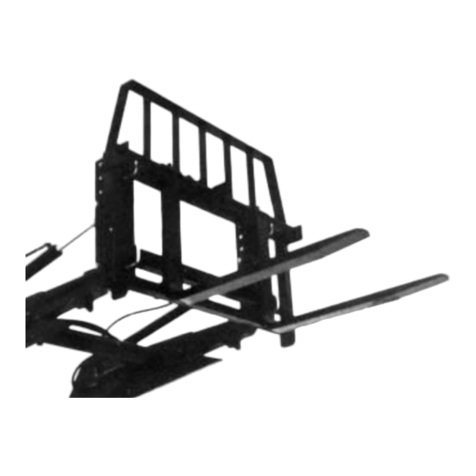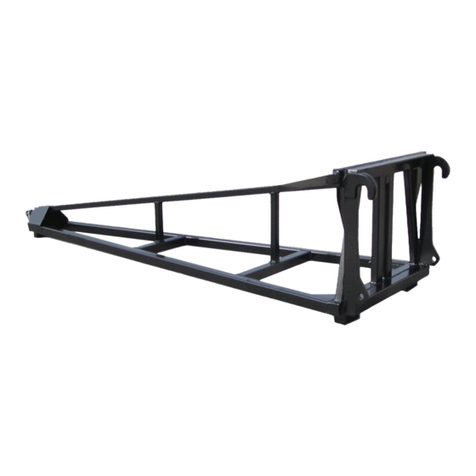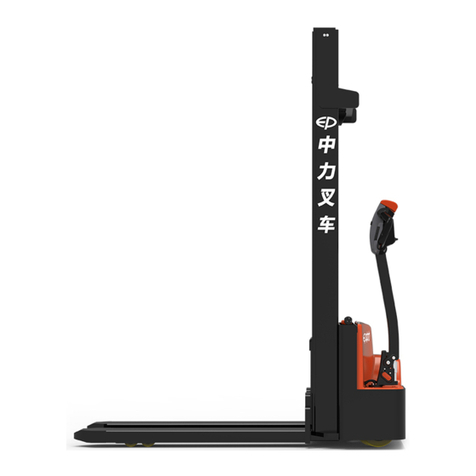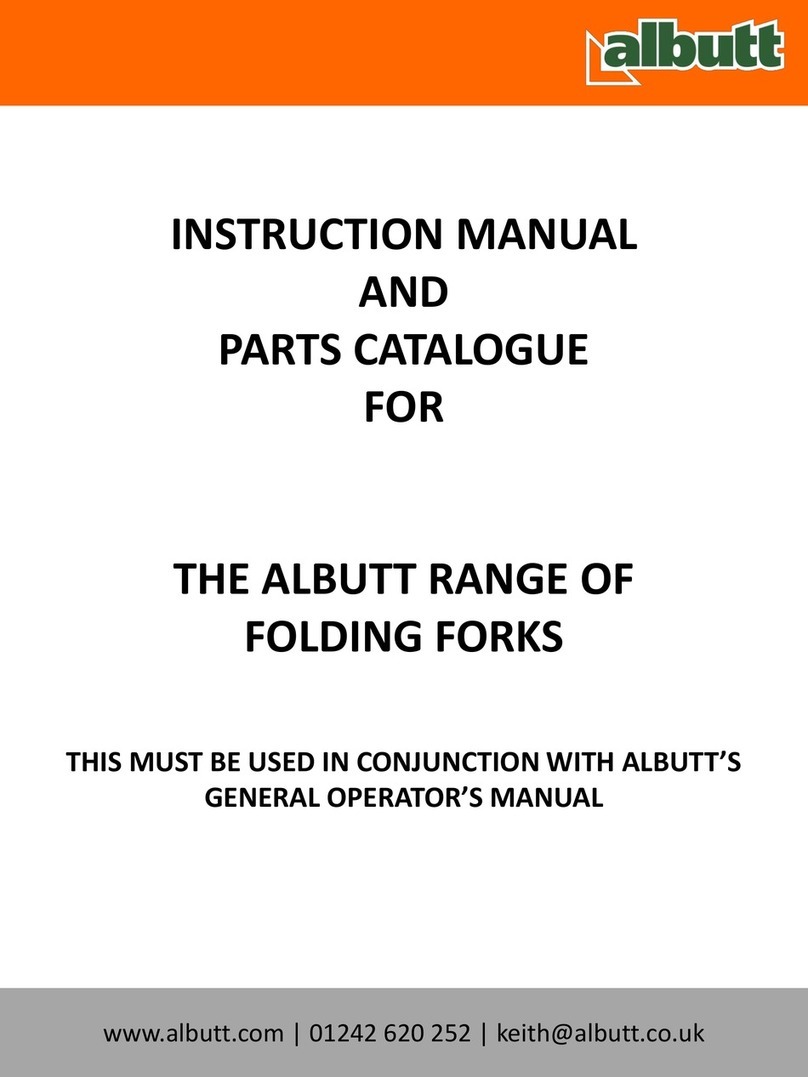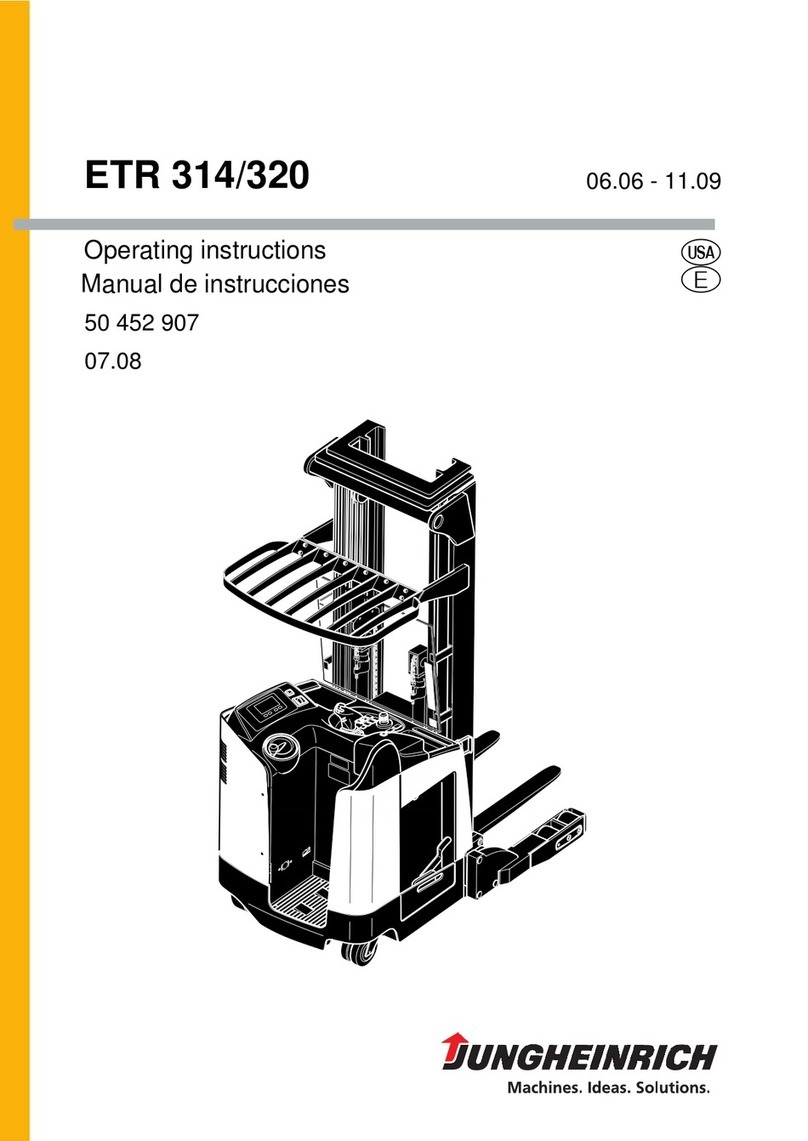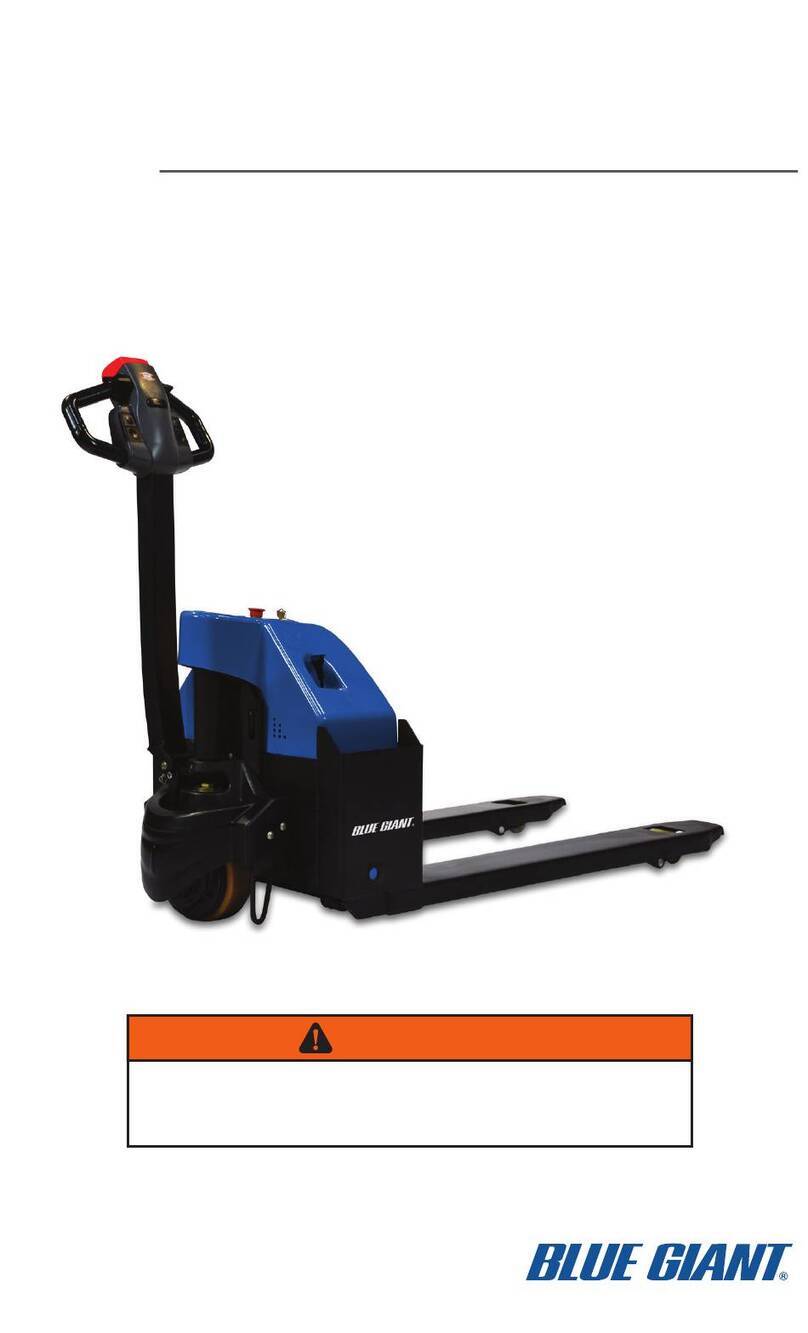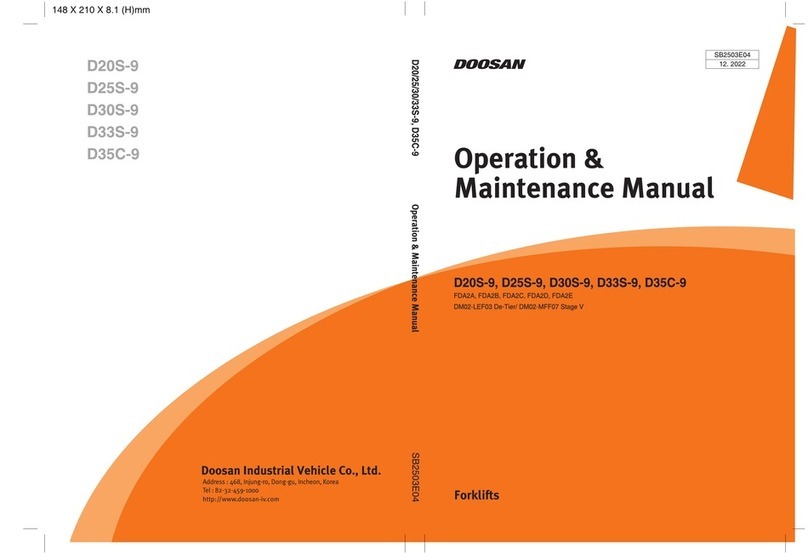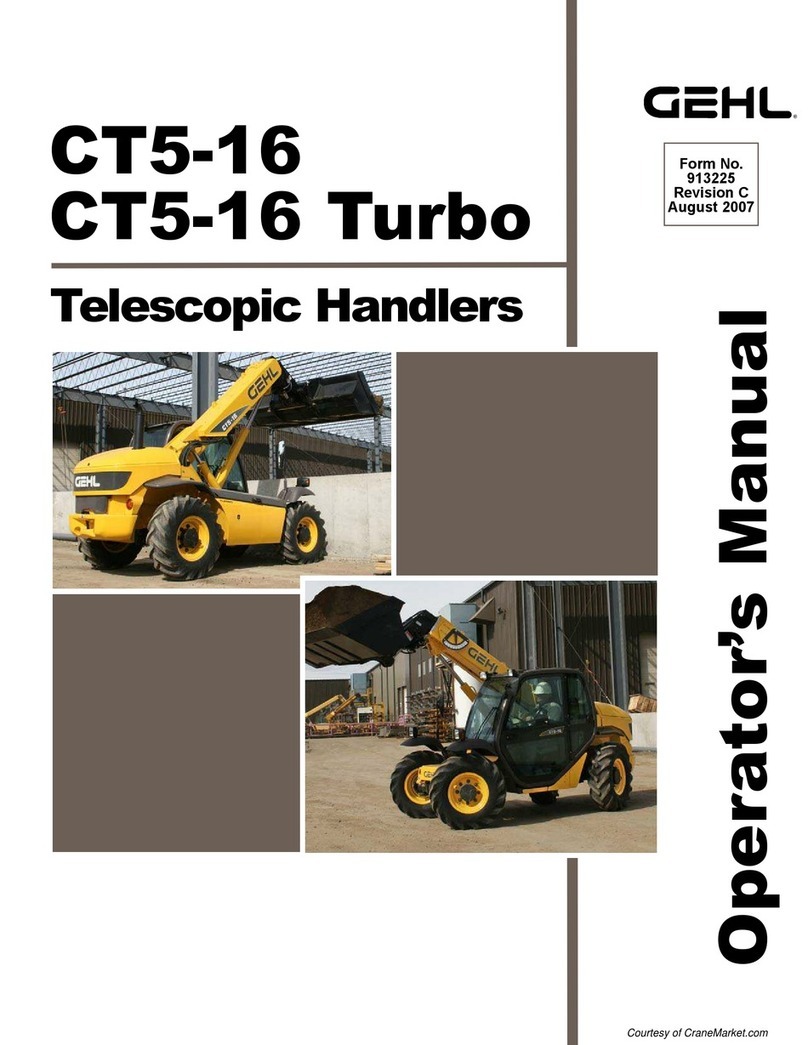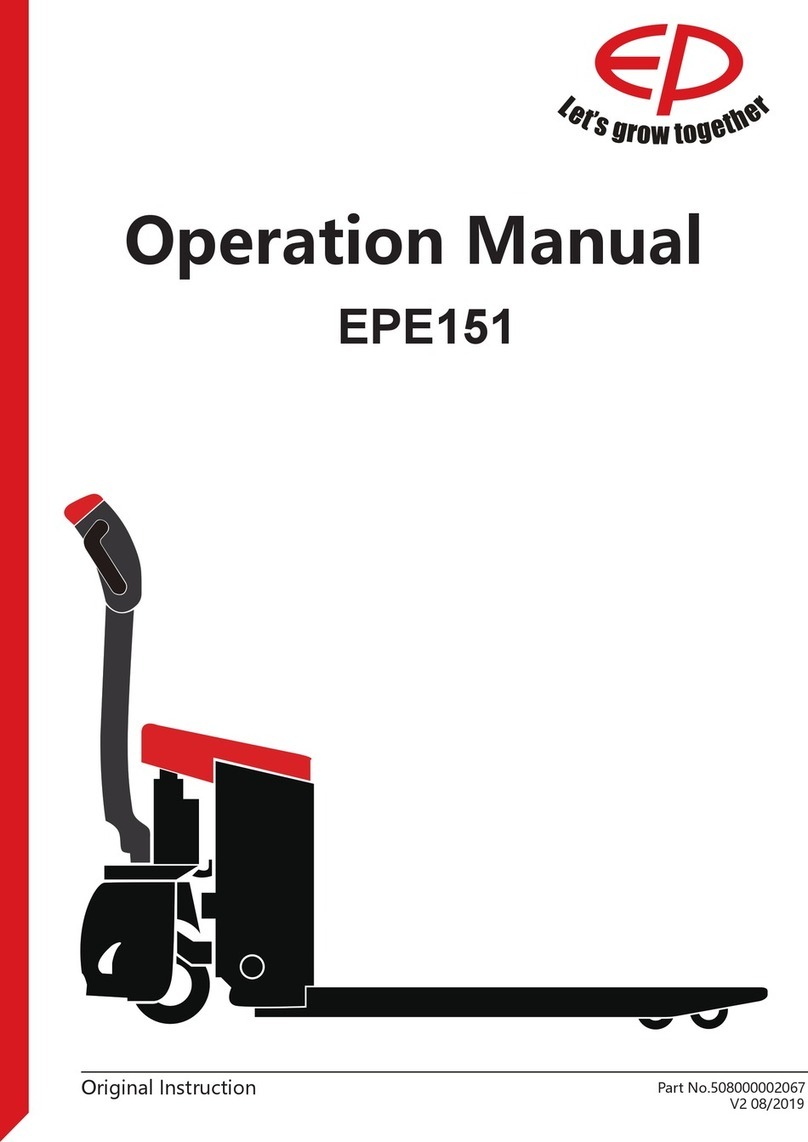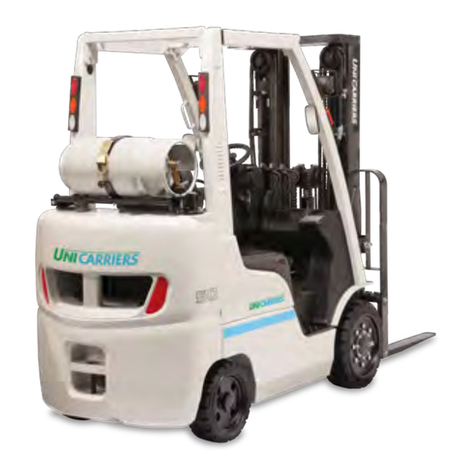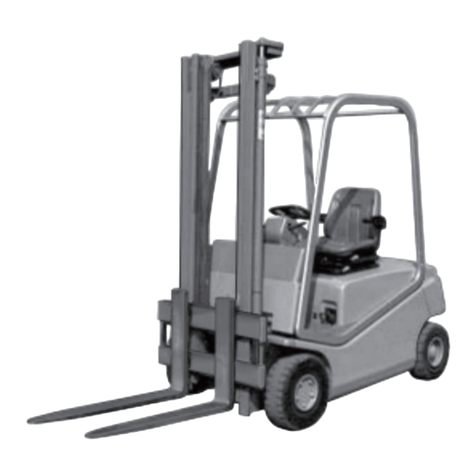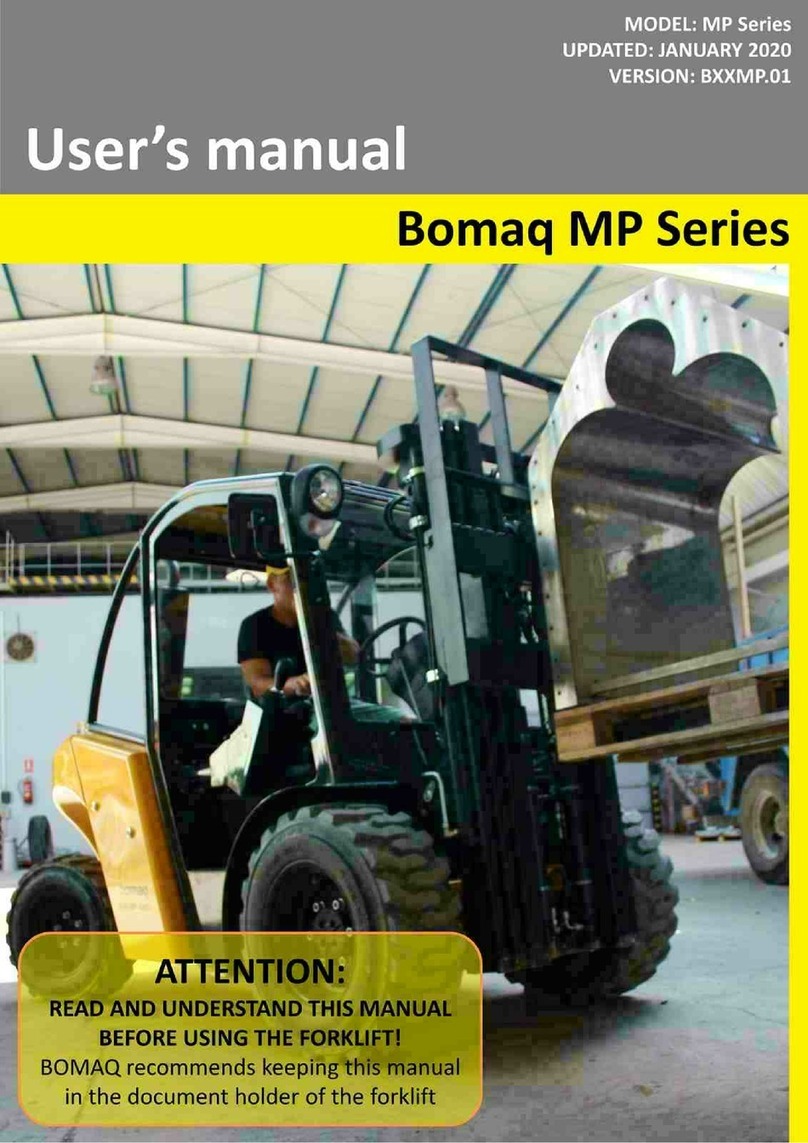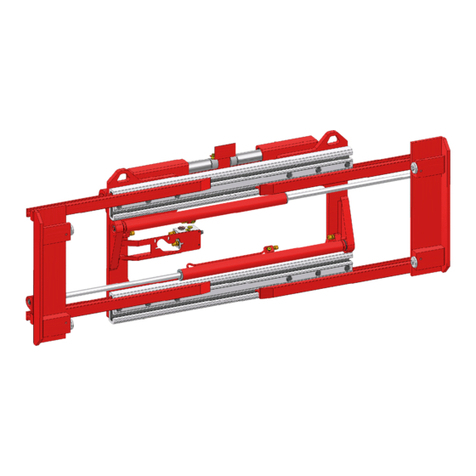Big Joe PDI Series User manual

Big Joe Manufacturing Company • Des Plaines, IL 60018 MANUAL NO. 901355
REV. B 0404
Manual Price $35.00
PDI SERIES
POWER DRIVE INTERMEDIATE
LIFT TRUCK
Serial Number 333375 to 376499
Operation
Maintenance
Repair Parts List
https://forklift-manuals.jimdofree.com

https://forklift-manuals.jimdofree.com

PDI0404 i
TABLE OF CONTENTS
Section Page Section Page
1 DESCRIPTION............................................................1-1
1-1. INTRODUCTION..............................................1-1
1-2. GENERAL DESCRIPTION...............................1-1
1-3. SAFETY FEATURES. ......................................1-2
1-4. OPTIONS AND ACCESSORIES......................1-2
2 OPERATION ...............................................................2-1
2-1. GENERAL. .......................................................2-1
2-2. OPERATING PRECAUTIONS. ........................2-1
2-3. BEFORE OPERATION.....................................2-2
2-4. POWER DRIVE CONTROL HANDLE..............2-5
2-4.1. CONTROL HANDLE. .......................................2-5
2-4.2. STEERING ARM CONTROLS.........................2-5
2-5. DRIVING AND STOPPING PROCEDURES....2-5
2-6. BELLY-BUTTON SWITCH GUARD.................2-6
2-7. STEERING ARM RETURN SPRING. ..............2-6
2-8. LIFT/LOWER CONTROL. ................................2-6
2-9. LOADING AND UNLOADING. .........................2-7
2-10. PARKING. .......................................................2-7
3 PLANNED MAINTENANCE ........................................3-1
3-1. GENERAL. .......................................................3-1
3-2. MONTHLY AND QUARTERLY CHECKS........3-1
3-3. WET CELL BATTERY CARE...........................3-1
3-3.1. GENERAL. .......................................................3-1
3-3.2. TIMER CHARGER OPERATION.....................3-2
3-3.3. SMART CHARGER OPERATION....................3-3
3-4. GEL CELL BATTERY CARE (OPTIONAL)......3-3
3-4.1. GENERAL. .......................................................3-3
3-4.2. CHARGING BATTERIES.................................3-3
3-4.3. REMOVING BATTERIES FROM CHARGER ..3-4
3-5. LUBRICATION. ................................................3-5
3-6. LIFT CHAIN MAINTENANCE...........................3-5
4 TROUBLESHOOTING ................................................4-1
4-1. GENERAL ........................................................4-1
4-2. SMART CHARGER 004978
TROUBLESHOOTING ....................................4-5
4-3. OPTIONAL GEL CELL BATTERY
CHARGER 004987 TROUBLESHOOTING .....4-8
4-3.1. DIP SWITCH SETTING ...................................4-8
4-3.2. THERMISTOR..................................................4-8
4-3.3. CIRCUIT BREAKER TESTING........................4-8
4-3.4. POWER TRANSFORMER TESTING...............4-8
4-3.5. CIRCUIT BOARD TESTING.............................4-8
5 STEERING ARM AND CONTROL HEADS
SERVICING.................................................................5-1
5-1. GENERAL. .......................................................5-1
5-2. COLD CONDITIONING....................................5-1
5-3. BELLY-BUTTON SWITCH ADJUSTMENT......5-2
5-4. CONTROL HEAD SWITCH
REPLACEMENT...............................................5-4
5-5. SPEED CONTROL SWITCH RETURN
SPRING REPLACEMENT............................... 5-4
5-6. STEERING ARM RETURN SPRING
ADJUSTMENT................................................. 5-6
5-7. STEERING ARM RETURN SPRING
REPLACEMENT.............................................. 5-6
5-8. PIVOT TUBE FLANGED BUSHING
REPLACEMENT.............................................. 5-8
5-9. ELECTRICAL CONTROL CABLE
REPLACEMENT............................................ 5-10
6 BRAKE SERVICING................................................... 6-1
6-1. ADJUSTMENT................................................. 6-1
6-2. REPLACEMENT OF DISC BRAKE PARTS.... 6-2
7 TRANSMISSION, DRIVE WHEEL,
ADJUSTABLE STRADDLE,AND LOAD
WHEEL SERVICING .................................................. 7-1
7-1. INITIAL DISASSEMBLY .................................. 7-1
7-2. DRIVE AXLE AND WHEEL REMOVAL........... 7-1
7-3. REMOVAL OF MOTOR AND BRAKE
ASSEMBLY INCLUDING DRIVE GEAR.......... 7-1
7-4. REMOVAL OF BRAKE DISC ASSEMBLY...... 7-1
7-5. ADJUSTABLE STRADDLE LIFT TRUCKS ..... 7-3
7-6. LOAD WHEELS............................................... 7-4
8 ELEVATION SYSTEM SERVICING........................... 8-1
8-1. GENERAL........................................................ 8-1
8-2. LIFT CHAIN LENGTH ADJUSTMENT............. 8-1
8-2.1. TELESCOPIC AND NON-TELESCOPIC......... 8-1
8-2.2. FULL FREE LIFT............................................. 8-2
8-3. LIFT CHAIN WEAR INSPECTION................... 8-2
8-4. LIFT CHAIN REPLACEMENT. ........................ 8-3
8-4.1. TELESCOPIC AND NON-TELESCOPIC......... 8-3
8-4.2. FULL FREE LIFT............................................. 8-5
8-5. LIFT CYLINDER REMOVAL............................ 8-5
8-5.1. NON-TELESCOPIC......................................... 8-5
8-5.2. TELESCOPIC.................................................. 8-5
8-5.3. FULL FREE LIFT............................................. 8-6
8-6. RAM HEAD REMOVAL. .................................. 8-6
8-6.1. NON-TELESCOPIC......................................... 8-6
8-6.2. TELESCOPIC.................................................. 8-6
8-7. YOKE SHEAVE REPLACEMENT
(FULL FREE LIFT)........................................... 8-7
8-8. LUBRICATION OF MAST................................ 8-7
9 HYDRAULIC SYSTEM SERVICING........................... 9-1
9-1. RELIEVING SYSTEM PRESSURE................. 9-1
9-2. FLOW CONTROL VALVE
REPLACEMENT.............................................. 9-1
9-3. SUCTION LINE FILTER REPLACEMENT. ..... 9-2
9-4. LINE OR FITTING REPLACEMENT................ 9-4
https://forklift-manuals.jimdofree.com

ii PDI0404
TABLE OF CONTENTS (Cont)
Section Page Section Page
9-5. LIFT/LOWER CONTROL VALVE.................... 9-4
9-5.1. ADJUSTMENT................................................. 9-4
9-5.2. DISASSEMBLY................................................ 9-5
9-5.3. PUMP MOTOR SWITCH ADJUSTMENT........ 9-6
9-6. HYDRAULIC PUMP AND MOTOR
ASSEMBLY...................................................... 9-6
9-6.1. PUMP AND MOTOR ASSEMBLY REMOVAL. 9-6
9-6.2. HYDRAULIC PRESSURE ADJUSTMENT...... 9-6
9-7. LIFT CYLINDER REPAIR................................ 9-7
9-7.1. NON-TELESCOPIC......................................... 9-7
9-7.2. TELESCOPIC.................................................. 9-7
9-7.3. FULL FREE LIFT........................................... 9-10
10 ELECTRICAL COMPONENTS................................. 10-1
10-1. ELECTRICAL CONTROL PANELS...............10-1
10-2. CONTROL PANEL SERVICING.................... 10-1
10-3. CONTACTOR SERVICING.
SERIAL NUMBER 333375 TO 364407..........10-3
10-3.1.2ND AND 3RD SPEED CONTACTOR
DISASSEMBLY.
SERIAL NUMBER 333375 TO 364407..........10-3
10-3.2.2ND AND 3RD SPEED CONTACTOR
REASSEMBLY.
SERIAL NUMBER 333375 TO 364407..........10-3
10-3.3.FORWARD-REVERSE CONTACTOR
DISASSEMBLY.
SERIAL NUMBER 333375 TO 364407..........10-4
10-3.4.FORWARD-REVERSE CONTACTOR
REASSEMBLY.
SERIAL NUMBER 333375 TO 364407..........10-5
10-4. PUMP MOTORS. ...........................................10-6
10-5. DRIVE MOTORS............................................10-6
10-6. BATTERY CHARGER....................................10-6
10-7. BATTERIES. ..................................................10-8
10-8. FUSE..............................................................10-8
10-9. HIGH SPEED LIMIT SWITCH......................10-10
10-10. HORN...........................................................10-10
11 OPTIONAL EQUIPMENT..........................................11-1
11-1. KEYSWITCH..................................................11-1
11-2. HOUR METER...............................................11-1
11-3. BATTERY CAPACITY INDICATOR...............11-1
11-4. REMOTE CONTROL. ....................................11-1
11-5. REMOTE CONTROL INSTALLATION...........11-1
11-5.1.PUSHBUTTON BOX REMOTE
CONTROL......................................................11-1
11-5.2.CONTROL HEAD LIFT/LOWER....................11-1
12 ILLUSTRATED PARTS BREAKDOWN ....................12-1
LIST OF ILLUSTRATIONS
Figure Page Figure Page
1-1 NAME PLATE .................................................... 1-1
1-2 SERIAL NUMBER AND DECAL LOCATION.....1-3
1-3 PDI LIFT TRUCK ............................................... 1-4
2-1 LOAD CENTER.................................................. 2-1
2-2 SAMPLE OF OPERATOR CHECK LIST ...........2-4
2-3 CONTROL HANDLE.......................................... 2-5
2-4 STEERING ARM BRAKING POSITION ............ 2-6
2-5 LIFT/LOWER LEVER......................................... 2-7
3-1 REINSTALLING THE BATTERY ....................... 3-2
3-2 CHARGE INDICATOR.......................................3-4
3-3 LUBRICATION DIAGRAM.................................3-6
4-1 BATTERY CHARGER SCHEMATIC ................. 4-5
4-2 LOGIC BOARD JUMPER POSITION................4-5
4-3 LOGIC FLOW DIAGRAM (SHEET 1) ................ 4-6
4-4 . DIP SWITCH SETTINGS...................................4-8
4-5 . BATTERY CHARGER WIRING DIAGRAM ....... 4-9
4-6 WIRING DIAGRAM (SHEET 1)........................ 4-10
4-7 WIRING DIAGRAM (SHEET 1)........................ 4-12
5-1 BELLY-BUTTON SWITCH ADJUSTMENT........ 5-1
5-2 SCHEMATIC OF COLD CONDITIONING
CIRCUIT.............................................................5-1
5-3 LOCATION OF RESISTORS AND
THERMAL CUTOUT SWITCH........................... 5-2
5-4 CONTROL HEAD ASSEMBLY.......................... 5-3
5-5 PUSH BUTTON SWITCHES ............................. 5-5
5-6 STEERING ARM AND ELECTRICAL CABLE... 5-7
5-7 PIVOT TUBE ASSEMBLY .................................5-8
5-8 PIVOT TUBE REMOVAL TOOL.........................5-9
5-9 ELECTRICAL CONTROL CABLE
REPLACEMENT...............................................5-11
6-1 BRAKE ENGAGE/DISENGAGE.........................6-1
6-2 ADJUSTMENT ...................................................6-2
6-3 PARTS REPLACEMENT....................................6-3
7-1 TRANSMISSION................................................7-2
7-2 ADJUSTABLE STRADDLE FRAME...................7-3
7-3 LOAD WHEELS..................................................7-4
8-1 ELEVATION SYSTEM (TELESCOPIC) .............8-1
8-2 ELEVATION SYSTEM (TELESCOPIC) .............8-2
8-3 ELEVATION SYSTEM (NON-TELESCOPIC)....8-3
8-4 ELEVATION SYSTEM (FULL FREE LIFT) ........8-4
9-1 HYDRAULIC SYSTEM SCHEMATIC.................9-1
9-2 HYDRAULIC SYSTEM (TELESCOPIC AND
NON-TELESCOPIC) ..........................................9-2
9-3 HYDRAULIC SYSTEM (FULL FREE LIFT)........9-3
9-4 LIFT/LOWER CONTROL VALVE
ADJUSTMENT ...................................................9-4
9-5 LIFT/LOWER CONTROL VALVE (STANDARD)9-5
9-6 LIFT/LOWER CONTROL VALVE
(COLD CONDITIONING)....................................9-5
9-7 LIFT CYLINDER (NON-TELESCOPIC)..............9-8
9-8 LIFT CYLINDER (TELESCOPIC).......................9-9
9-9 LIFT CYLINDER (FULL FREE LIFT)................9-11
10-1 ELECTRICAL CONTROL PANEL....................10-1
10-2 ELECTRICAL CONTROL PANEL....................10-2
https://forklift-manuals.jimdofree.com

PDI0404 iii
LIST OF ILLUSTRATIONS (Cont)
Figure Page Figure Page
10-3 CONTACTOR (2ND AND 3RD SPEED)
PART NUMBER 005659 ..................................10-4
10-4 CONTACTOR (FORWARD-REVERSE)
PART NUMBER 005657 ..................................10-5
10-5 BATTERY CHARGER 004967-01 AND
004967-02 SCHEMATIC ..................................10-6
10-6 BATTERY CHARGER 004976-01
SCHEMATIC ....................................................10-7
10-7 BATTERY CHARGER 004978 SCHEMATIC...10-7
10-8 BASE, FRAME AND ELECTRICAL
COMPONENTS................................................10-9
10-9 ELECTRICAL COMPONENTS.......................10-10
12-1 CONTROL HEAD ASSEMBLY.........................12-2
12-2 PUSH BUTTON SWITCHES, CONTROL
HEAD................................................................12-4
12-3 COLD CONDITIONING, CONTROL HEAD......12-5
12-4 STEERING ARM AND ELECTRICAL CABLE..12-6
12-5 PIVOT TUBE ASSEMBLY................................12-8
12-6 BRAKE AND LINKAGE ..................................12-10
12-7 TRANSMISSION ............................................12-12
12-8 DRIVE MOTOR 016046 .................................12-14
12-9 DRIVE MOTOR 016052 .................................12-15
12-10 BASE AND FRAME........................................12-16
12-11 DECAL LOCATION ........................................12-18
12-12 ADJUSTABLE STRADDLE FRAME...............12-19
12-13 LOAD WHEELS..............................................12-19
12-14 ELEVATION SYSTEM (TELESCOPIC)..........12-20
12-15 ELEVATION SYSTEM (TELESCOPIC)..........12-22
12-16 ELEVATION SYSTEM (NON-TELESCOPIC) 12-24
12-17 ELEVATION SYSTEM (FULL FREE LIFT).....12-26
12-18 LIFT CARRIAGE AND FORKS.......................12-28
12-19 HYDRAULIC SYSTEM (TELESCOPIC AND
NON-TELESCOPIC).......................................12-30
12-20 HYDRAULIC SYSTEM (FULL FREE LIFT)....12-31
12-21 LIFT CYLINDER (NON-TELESCOPIC)..........12-32
12-22 LIFT CYLINDER (TELESCOPIC)....................12-34
12-23 LIFT CYLINDERS (FULL FREE LIFT)........... 12-36
12-24 LIFT CONTROL VALVE (STANDARD)......... 12-38
12-25 LIFT CONTROL VALVE
(COLD CONDITIONING)............................... 12-38
12-26 BATTERIES................................................... 12-40
12-27 QUICK DISCONNECT CABLE
INSTALLATION ............................................. 12-42
12-28 ELECTRICAL COMPONENTS...................... 12-44
12-29 HYDRAULIC PUMP AND MOTOR 905046... 12-46
12-30 HYDRAULIC PUMP AND MOTOR
ASSEMBLY 016935....................................... 12-47
12-31 HYDRAULIC PUMP AND MOTOR
ASSEMBLY 016942....................................... 12-48
12-32 HYDRAULIC PUMP AND MOTOR
ASSEMBLY 016940....................................... 12-49
12-33 ELECTRICAL CONTROL PANEL ................. 12-50
12-34 ELECTRICAL CONTROL PANEL ................. 12-51
12-35 CONTACTOR (2ND AND 3RD SPEED)........ 12-52
12-36 CONTACTOR (FORWARD/REVERSE)........ 12-52
12-37 "SMART" BATTERY CHARGER
INSTALLATION ............................................. 12-53
12-38 GEL CELL BATTERY CHARGER................. 12-54
12-39 BATTERY CHARGER MOUNTING............... 12-55
12-40 OPTIONAL "SMART" CHARGER 004976-01
(REPLACES TIMER CHARGER 004967-01) 12-56
12-41 STANDARD TIMER BATTERY CHARGER
004967-01 AND 004967-02........................... 12-57
12-42 OPTIONAL KEYSWITCH .............................. 12-58
12-43 OPTIONAL HOUR METER............................ 12-58
12-44 OPTIONAL BATTERY CAPACITOR
INDICATOR................................................... 12-59
12-45 OPTIONAL BATTERY CAPACITOR
INDICATOR................................................... 12-60
12-46 OPTIONAL REMOTE CONTROL
INSTALLATION ............................................. 12-61
LIST OF TABLES (Cont)
Table Page Table Page
2-1 OPERATOR CHECKS .........................................2-2
3-1 MONTHLY AND QUARTERLY
INSPECTION AND SERVICE CHART.................3-1
3-2 CHARGER TIME FOR BATTERY CHARGING ...3-3
3-3 RECOMMENDED LUBRICANTS........................ 3-5
3-4 LUBRICATION CHART ....................................... 3-6
4-1 TROUBLESHOOTING CHART ............................ 4-1
10-1 BATTERY CHARGERS..................................... 10-6
https://forklift-manuals.jimdofree.com

iv PDI0404
OPERATOR INSTRUCTIONS
WARNING
Do not operate this truck unless you have been trained
and authorized to do so and have read all warnings
and instructions in operator's manual and on this truck.
Do not operate this truck until you have checked its
condition. Give special attention to Tires, Horn, Lights,
Battery, Controller, Lift System, (including forks or
attachments, chains, cables and limit switches),
Brakes, Steering Mechanism, Guards and Safety
Devices.
Operate truck only from designated operating position.
Never place any part of your body into the mast struc-
ture or between the mast and the truck. Do not carry
passengers. Keep feet clear of truck.
Observe applicable traffic regulations. Yield right of
way to pedestrians. Slow down and sound horn at
cross aisles and wherever vision is obstructed.
Start, stop, travel, steer and brake smoothly. Slow
down for turns and on uneven or slippery surfaces that
could cause truck to slide or overturn. Use special
care when traveling without load as the risk of overturn
may be greater.
Travel with lifting mechanism as low as possible.
Always look in direction of travel. Keep a clear view,
and when load interferes with visibility, travel with load
or lifting mechanism trailing, except when traveling
downhill.
Use special care when operating on ramps—travel
slowly, and do not angle or turn. Travel with lifting
mechanism or load downhill.
Do not overload truck. Check capacity plate for load
weight and load center information.
When using forks, space forks as far apart as load will
permit. Before lifting, be sure load is centered, forks
are completely under load, and load is far back as pos-
sible against load backrest.
Do not handle unstable or loosely stacked loads. Use
special care when handling long, high or wide loads to
avoid losing the load, striking bystanders, or tipping
the truck.
Do not handle loads which are higher than the load
backrest or load backrest extension unless load is
secured so that no part of it could fall backward.
Elevate forks or other lifting mechanism only to pick up
or stack a load. Watch out for obstructions, especially
overhead.
Do not lift personnel except on a securely attached
specially designed Work Platform. Use extreme care
when lifting personnel. Make sure mast is vertical,
place truck controls in neutral and apply brakes. Lift
and lower smoothly. Remain in operating position or
immediate vicinity as long as personnel are on the
Work Platform. Never transport personnel on forks or
Work Platform.
Do not allow anyone to stand or pass under load or lift-
ing mechanism.
When leaving truck, neutralize travel control. Fully
lower lifting mechanism and set brake. When leaving
truck unattended, also shut off power.
PREPARATION FOR USE
Upon receipt, visually inspect the truck. If any damage
is found, report it to the carrier and to your Big Joe
dealer immediately.
Remove cardboard banded to forks. Check lift truck for
scratches and dents. Check to make sure that the lift
chains are free of slack. Inspect for oil leaks and loose
wiring connections. Make certain that all accessories
and attachments that were ordered are supplied.
Before the lift truck is moved, the battery must be
checked, recharged if necessary, and connected.
Refer to “Battery Care” in SECTION 3 for battery
checking instructions.
If you did not order an optional charge cord (Fig-
ure 12-38 or Figure 12-39) then purchase an exten-
sion cord, 16 gauge, 3 wire, UL approved of the
type normally used for shop tools, heavier appli-
ances, etc.
Refer to Section 2 for operating instructions to test the
brakes and lift control.
If you do not obtain the proper results, or if improper
operation occurs, refer to troubleshooting in SECTION
4.
https://forklift-manuals.jimdofree.com

PDI0404 1-1
SECTION 1
DESCRIPTION
1-1. INTRODUCTION.
This publication describes the Power Drive Intermedi-
ate (PDI) lift truck manufactured by Big Joe Manufac-
turing Company, Des Plaines, Illinois, 60018. Included
are operating instructions, planned maintenance
instructions, lubrication procedures, corrective mainte-
nance procedures and a complete parts list with parts
location illustrations.
Users shall comply with all requirements indicated in
applicable OSHA standards and current edition of
A.N.S.I. B56.1 Part II. By following these requirements
and the recommendations contained in this manual,
you will receive many years of dependable service
from your Big Joe lift truck.
The lift truck is identified by a model number. The
model number shows truck capacity and load center. A
typical model number is explained below.
Figure 1-1 Name Plate
The model number will be found on the (Figure 1-1)
along with the serial number, lifting capacity, and load
center. Figure 1-3 shows the locations of the trucks
main components and controls. Figure 1-2 shows the
location and identification of the decals. Also listed is
the touchup paint used on both the older and new
model PDI trucks as well as the location of the trucks
serial number and name plate.
1-2. GENERAL DESCRIPTION.
The self-propelled PDI truck, Figure 1-3, lifts and
transports payloads up to 2000 pounds on either rigid
or adjustable forks.
The forward and reverse motion is controlled by the
speed controller switch in the control head. Stopping
and turning is controlled by the steering arm. Lift and
Lower is controlled by either a lever mounted on the
chassis, optional pushbutton controls located on the
steering arm, or a control box attached by a coiled
cord.
R6209
https://forklift-manuals.jimdofree.com

1-2 PDI0404
The battery-powered lift truck is quiet and without
exhaust fumes.
The reversible dc motor propels the lift truck in forward
and reverse direction throughout the available speed
range. The PDI lift truck can be driven with forks raised
or lowered; however, the speed is restricted when the
forks are raised above a preset limit.
1-3. SAFETY FEATURES.
The PDI is designed and engineered to provide maxi-
mum safety for operator and payload. Some of the
safety features incorporated into the design are:
Dead-man brake to apply mechanical brake and cut off
drive power when the steering arm is released.
Belly-button switch to reverse truck should the opera-
tor accidentally pin himself against a wall or obstruc-
tion when backing up.
High speed limit switch to restrict speed when lift car-
riage is raised above the preset limit.
All control functions automatically return to “OFF”
when released.
Externally accessible quick-disconnect battery plug
within operator's reach.
Separately fused control circuits and power circuits.
Readily accessible HORN button.
Lift carriage backrest to help stabilize the load.
Pressure compensated flow control valve regulates
maximum lowering speed within prescribed limits.
High visibility color scheme of truck provides visual
alert of trucks presence.
1-4. OPTIONS AND ACCESSORIES.
Big Joe offers many options and accessories for the
PDI lift truck such as:
Key switch
Remote Lift/Lower Control in Control Arm or Remote
Control Box Attached by a Coiled Cord or both
Wider Lift Carriage
Cold Conditioning
Battery Capacity Indicator with or without Lift Lockout
Hour Meter For Motors
Longer Carriage Forks
Dry Charged Batteries
240 V, 60 Hz, Single Phase Charger
48 inch Load Backrest Extension
Adjustable Straddles
RAMS
Boom w/Hook
Slip-on Platform...smooth or diamond surface
Roller Platform
Work Platform
Transistor Control
The most commonly used options and accessories are
described in SECTION 11.
https://forklift-manuals.jimdofree.com

PDI0404 1-3
Figure 1-2 Serial Number and Decal Location
R5801
TOUCH-UP PAINT
901201 YELLOW
901202 BLACK
905001 DECAL KIT
PART NO. DESCRIPTION QTY.
056478 LIFT-LOWER 1
056499 NO RIDING 1
056564 CAUTION 2
056494 CAUTION 2
056610 WARNING 1
056625 WARNING 1
056626 OIL LEVEL 1
056632 BIG JOE (MAST) 2
056644 TRUCK-CHARGE 1
056646 DANGER-BATTERY 1
056648 INSTR-CHARGER 1
https://forklift-manuals.jimdofree.com

1-4 PDI0404
Figure 1-3 PDI Lift Truck
R3813
https://forklift-manuals.jimdofree.com

PDI0404 2-1
SECTION 2
OPERATION
2-1. GENERAL.
This section gives detailed operating instructions for
the PDI lift truck. The instructions are divided into the
various phases of operations, such as operating the
lift, driving, and stopping. Routine precautions are
included for safe operation.
2-2. OPERATING PRECAUTIONS.
WARNING: Improper operation of the lift truck may
result in operator injury, or load and/or lift
truck damage. Observe the following
precautions when operating the PDI lift
truck.
1. Do not operate this truck unless you have been
trained and authorized to do so. Read all warn-
ings and instructions in this manual and on the lift
truck.
2. Do not operate this truck until the periodic inspec-
tion or service has been completed.
3. Do not exceed the rated capacity (see name
plate). Overloading may result in damage to the
hydraulic system and structural components.
4. Do not handle unstable or loosely stacked loads.
Use special care when handling long, high, or
wide loads to avoid tipping, loss of load, or striking
bystanders.
5. Center and carry the load as far back as possible
toward the lift carriage back rest. Do not pick up
loads on the tips of forks. The center-of-gravity of
the load must not exceed the load center listed on
the name plate. See Figure 2-1 for load center
limitations.
6. Pick up loads on both forks. Do not pick up loads
on only one fork.
7. When traveling, always lower the load as far as
possible.
8. When stacking pallets in racks and it is necessary
to move the load in the raised position, use cau-
tion. Operate truck smoothly.
9. Check for obstructions when raising or lowering
the lift carriage.
10. Apply the brake gently except in cases of emer-
gency.
Figure 2-1 Load Center
1. SEE SUPPLEMENT 207 FOR TRANSISTOR
CONTROL HEAD USED ON TRUCKS SERIAL
NUMBER 333375 TO 334630
2. SEE SUPPLEMENT 220 FOR TRANSISTOR
CONTROL HEAD USED ON TRUCKS SERIAL
NUMBER 334631 TO 376499
3. SEE SUPPLEMENT 187 FOR TRANSISTOR
CONTROLLER USED ON TRUCKS SERIAL
NUMBER 333375 TO 338589
4. SEE SUPPLEMENT 233 FOR TRANSISTOR
CONTROLLER USED ON TRUCKS SERIAL
NUMBER 338590 TO 372811
5. SEE SUPPLEMENT 349 FOR TRANSISTOR
CONTROLLER USED ON TRUCKS SERIAL
NUMBER 372812 TO 376499
R3814
https://forklift-manuals.jimdofree.com

2-2 PDI0404
11. Observe applicable traffic regulations. Yield right
of way to pedestrians. Slow down and sound horn
at cross aisles and wherever vision is obstructed.
12. Operate truck only from designated operating
position. Never place any part of your body
between the mast uprights. Do not carry passen-
gers.
13. Do not allow anyone to stand or pass under load
or lifting mechanism.
2-3. BEFORE OPERATION
Table 2-1 covers important inspection points on PDI lift
truck which should be checked prior to operation.
Depending on use, some trucks may require additional
checks.
Figure 2-2 shows a sample format for a Operator
Checklist, which can be modified as necessary to fit
your operation.
WARNING: Periodic maintenance of this truck by a
QUALIFIED TECHNICIAN is required.
CAUTION: A QUALIFIED SERVICE TECHNICIAN
should check the truck monthly for
proper lubrication, proper fluid levels,
brake maintenance, motor maintenance
and other areas specified in the SEC-
TION 3.
WARNING: If the truck is found to be unsafe and in
need of repair, or contributes to an
unsafe condition, report it immediately to
the designated authority. Do not operate
it until it has been restored to a safe
operating condition. Do not make any
unauthorized repairs or adjustments. All
service must be performed by a qualified
maintenance technician.
Table 2-1 Operator Checks
ITEM PROCEDURE
Transmissionand
hydraulic sys-
tems.
Check for signs of fluid leakage.
Forks Check for cracks and damage;
and, that they are properly
secured.
Chains, cables
and hoses Check that they are in place,
secured correctly, functioning
properly and free of binding or
damage.
Guards and load
backrest Check that safety guards are in
place, properly secured and not
damaged.
Safety signs Check that warning labels,
nameplate, etc., are in good
condition and legible.
Horn Check that horn sounds when
operated.
Steering Check for bindingor looseness in
steering arm when steering.
Travel controls Check that speed controls on
control handle operate in all
speed ranges in forward and
reverse and that belly button
switch functions.
Wheels Check drive wheel for cracks or
damage. Move truck to check
load and caster wheels for free-
dom of rotation.
Hydraulic
controls Check operation of lift and lower
to their maximum positions.
Brakes Check that brakes actuate when
steering arm is raised to upright
position, and when lowered to
horizontal position. Check that
dynamic brake (if so equipped)
actuates when dynamic brake
pushbutton on control handle is
pressed.
Deadman/
Parking brake Check that steering arm raises to
upright position when released
and brake applies.
Battery discon-
nect Check that battery can be
disconnected and recon-
nected. Check for connector
damage.
Battery charge Check that battery capacity
meter (if equipped) is on “F”.
High speed limit
switch Allow for enough space to oper-
ate truck in high speed. Elevate
forks approximately two feet,
then test drive truck to check if
high speed is cut out.
ITEM PROCEDURE
https://forklift-manuals.jimdofree.com

PDI0404 2-3
Figure 2-2 Sample of Operator Check List
R5699
https://forklift-manuals.jimdofree.com

2-4 PDI0404
2-4. POWER DRIVE CONTROL HANDLE.
2-4.1. Control Handle.
Two triangular shaped speed controls provide for easy
thumb actuation. Standard controls include three for-
ward and three reverse speeds, a belly-button revers-
ing switch, and a horn. See Figure 2-3.
2-4.2. Steering Arm Controls.
Lowering the steering arm to the horizontal or raising
to the vertical applies the brake (See Figure 2-4). All
traction control power is shut off when the brake is
engaged. When the steering arm is in the upright posi-
tion, the brake acts as a parking brake. Deadman
braking occurs when the handle is released and spring
action raises it to the vertical position.
Optional are Lift and Lower pushbuttons. The Lift and
Lower pushbuttons are located behind the belly-button
switch guard and can also be operated from either
side. Also optional is a Lift and Lower remote control
box.
When the lower portion of the triangular speed control
knob is pressed forward, contacts are closed for first
speed in the forward direction. Pressing the speed
control farther closes a contact for second speed and
farther, third speed. Pressing the upper portion of the
speed control governs the three reverse speeds in the
same manner.
When the rotating grips are utilized, forward direction
is achieved by rotating the grips downward. Reverse
direction is achieved by rotating the grips upward. Fur-
ther rotation in either direction will actuate second and
third speeds in forward or reverse.
2-5. Driving and Stopping Procedures.
The following procedure describes driving and stop-
ping the PDI lift truck. If the lift truck is equipped with a
key switch, turn it to the on position.
1. Grasp the grips of the steering arm so that the
speed control can be comfortably operated by
either the thumbs, or the palms of the hands if
rotating grips are being utilized.
2. Lower the steering arm to a comfortable position
above horizontal to disengage the brake and to
energize the electrical circuits.
Figure 2-3 Control Handle
1. SEE SUPPLEMENT 207 FOR
TRANSISTOR CONTROL HEAD
USED ON TRUCKS SERIAL
NUMBER 333375 TO 334630
2. SEE SUPPLEMENT 220 FOR
TRANSISTOR CONTROL HEAD
USED ON TRUCKS SERIAL
NUMBER 33461 TO 376499
R3815
https://forklift-manuals.jimdofree.com

PDI0404 2-5
Figure 2-4 Steering Arm Braking Position
3. To move forward, slowly press the lower portion of
the speed control or rotate the grips downward.
Press the forward speed control or rotate the grips
farther to increase speed.
4. To stop, release the speed control and lower the
steering arm to the horizontal position. In this
position, the brake pads apply light pressure to
the brake disc. Lowering the steering arm further
increases the braking force.
The brake may also be applied by raising the
steering arm to the upright position.
5. To travel in reverse, lower the steering arm to a
comfortable position and slowly press the upper
portion of the speed control or rotate the grips
upward.
NOTE: Acceleration in reverse is the same as in the
forward direction.
2-6. BELLY-BUTTON SWITCH GUARD.
The belly-button switch guard minimizes the possibility
of the driver being pinned by the steering arm while
driving the lift truck in reverse. If the guard presses
against the driver while the lift truck is being driven in
reverse, the guard actuates a switch which changes
the direction of the lift truck to forward direction in low
speed.
2-7. STEERING ARM RETURN SPRING.
The steering arm return spring automatically raises
the steering arm to the upright position when the
steering arm is released. If the steering arm snaps up
abruptly, or does not return fully, the steering arm
return spring requires adjustment. Return truck to
maintenance group for adjustment.
2-8. LIFT/LOWER CONTROL.
The LIFT/LOWER control, Figure 2-5, is used to lift the
forks and to regulate their lowering. The rate of rise is
fixed, however, the descent of the forks is infinitely
variable. The farther the control lever is moved from
neutral position, the faster the forks will descend.
If the optional LIFT and LOWER pushbuttons on the
control handle or optional LIFT (UP) and LOWER
(DOWN) remote control box are used, the lift carriage
raises and descends at a fixed rate of speed.
Proceed as follows to raise and lower the forks. If truck
is equipped with a key switch, turn it to the on position.
R3629
https://forklift-manuals.jimdofree.com

2-6 PDI0404
Figure 2-5 Lift/Lower Lever
WARNING: Check the space above the mast and the
load to be sure that there is sufficient
room for raising the forks. Make sure the
load is centered and does not exceed
capacity.
1. To raise the forks, pull LIFT control lever toward
UP position (toward operator), and hold it until the
forks reach the desired height; then return LIFT
control lever to its neutral position. If truck is
equipped with pushbuttons, push in the LIFT but-
ton and hold until lift carriage reaches desired lift
height.
2. To lower the forks, push LIFT control lever toward
DOWN position (away from operator), and hold it
until the forks reach the desired height. Then
return LIFT control lever to its neutral position. If
truck is equipped with the optional LOWER push-
button, push in and hold the LOWER button until
lift carriage is at the desired height.
2-9. LOADING AND UNLOADING.
1. Move truck to location where load is to be picked
up.
2. Adjust forks to maximum practical width.
3. Raise forks to desired height. Move truck into
position so forks are within pallet or skid, and the
load is centered over the forks and as far back as
possible.
4. Raise forks slightly to lift load from rack.
5. Slowly reverse the truck to move load free from
rack. When the load is clear, lower the load, leav-
ing enough floor clearance to maneuver truck.
6. Drive to area where load is to be placed.
7. Move truck to align load with its new position.
Raise forks to desired height.
8. Lower the load until it rests squarely in place and
forks are free.
9. Slowly move the truck straight backward, making
sure the forks do not catch on the pallet. Lower
the forks when they are clear.
2-10. PARKING.
When finished with moving loads, drive truck to its
maintenance or storage area. Disconnect batteries
from TRUCK receptacle and connect to CHARGER
receptacle. Charge batteries as necessary. Refer to
battery care instructions, paragraph 3-3. or 3-4.
R5802
https://forklift-manuals.jimdofree.com

PDI0404 3-1
SECTION 3
PLANNED MAINTENANCE
3-1. GENERAL.
Planned maintenance consists of periodic visual and
operational checks, parts inspection, lubrication, and
scheduled maintenance designed to prevent or dis-
cover malfunctions and defective parts. The operator
performs the checks in SECTION 2, and refers any
required servicing to a qualified maintenance techni-
cian who performs the scheduled maintenance and
any required servicing.
3-2. MONTHLY AND QUARTERLY CHECKS.
Table 3-1 is a monthly and quarterly inspection and
service chart based on normal usage of equipment
eight hours per day, five days per week. If the lift truck
is used in excess of forty hours per week, the fre-
quency of inspection and service should be increased
accordingly. These procedures must be performed by
a qualified service technician or your Big Joe service
representative.
3-3. WET CELL BATTERY CARE.
3-3.1. General.
The life of the battery can be extended by giving it
proper care. Perform a daily check of the battery
whether or not the equipment is in daily use. DO NOT
overcharge the battery or battery life will be shortened.
DO NOT allow battery to become completely dis-
charged (specific gravity 1.150 or less). This will also
greatly shorten battery life.
CAUTION: Observe and adhere to battery safety
and maintenance supplement (Docu-
ment 245) and battery warning decal
when servicing battery charger.
After charging, check the water level in each cell.
Water level must cover plates but not be higher than
the base of the battery cell filler neck.
Table 3-1 Monthly and Quarterly Inspection and Service Chart
VISUAL CHECKS
INTERVAL INSPECTION OR SERVICE
Monthly Check condition of drive motor commutator, brushes and springs
Monthly Check condition of pump motor commutator, brushes and springs
Monthly Check mechanical brake for proper operation
Monthly Check load wheels for wear
Monthly Check drive wheel for wear
Monthly Inspect wiring for loose connections and damaged insulation
Monthly Inspect contactor tips for excessive pitting and wear
Monthly Check deadman brake switch for proper operation
Monthly Check lift chain tension, lubrication & operation (see paragraph 3-6.)
Quarterly Check lift cylinder wiper ring and packing for leakage
Quarterly Check for excessive jerking of steering arm when stopping or starting
Semi-annually Replace hydraulic filter assembly
Semi-annually Inspect for chain wear (See pargraph 8-3.)
https://forklift-manuals.jimdofree.com

3-2 PDI0404
3-3.2. Timer Charger Operation.
The batteries must be pulled out of the compartments
in order to check the specific gravity.
Truck Serial Number 342392 To 376499, remove
screw, washer and retainer bar by each battery.
CAUTION: These batteries are heavy. Use handles
on battery when lifting.
Remove batteries from the right side of the truck. The
battery connecting cables are sufficiently long to allow
batteries to be placed on the floor. It is not necessary
to disconnect the battery cables.
When reinstalling the battery be sure battery cable
connectors are securely attached to the battery termi-
nals, and cables are routed and secured to the battery
as shown in Figure 3-1.
Truck Serial Number 342392 To 376499, reinstall
and position battery retainer bar to prevent battery
movement in excess of 1/2".
Use the following procedure:
1. Obtain a battery hydrometer.
NOTE: These can be obtained from a local hardware
store or automotive shop.
2. Use the hydrometer to check specific gravity of
each cell.
NOTE: Battery specific gravity readings should agree
within + 0.025 from cell to cell. If variation is
greater, the battery may have to be repaired
or replaced.
Figure 3-1 Reinstalling the Battery
USED ON TRUCKS
SERIAL NUMBERS
342392 TO 376499
R5803
https://forklift-manuals.jimdofree.com

PDI0404 3-3
CAUTION: Be sure that no cell plates are exposed
(not covered by fluid) before charging.
Add distilled water sufficient to just cover
top of cell plates.
CAUTION: Use distilled water. Impurities in tap
water will damage battery plates.
3. When using a timer charger, charge battery in
accordance with Table 3-2. When using the
"smart" charger charge battery as described in
paragraph 3-3.3.
NOTE: A fully charged battery has a specific gravity
of 1.260 to 1.275.
3-3.3. Smart Charger Operation.
Big Joe "Smart" Chargers incorporate computer logic
circuits to provide full automatic recharging and shut
off operation for convenient overnight service.
The operation of this charger is completely automatic.
1. Turn key switch off, if equipped.
2. Check battery fluid levels (SEE Supplement Bat-
tery Safety and Maintenance Document 245).
3. Plug AC cord into proper AC power source. Dis-
connect DC battery supply from the truck and
connect it to the charger circuit. After a short
delay the charger will start.
Table 3-2 Charger TIme for Battery Charging
CAUTION: Do not use truck while charger is
plugged in.
4. Charger output will decrease as batteries
recharge.
5. Trucks Serial Numbers 344163 To 376499:
When ammeter reads near 0, charge cycle is
complete. The ammeter needle may cycle
momentarily to a higher reading and fall back to
near 0. The red charger light stays on until the
charger is unplugged from AC outlet.
Trucks Serial Numbers 333375 to 344163:
When charger light is off, charge cycle is com-
plete.
6. Disconnect AC power cord, wind up cord on cord
winder.
7. Disconnect DC battery supply from the charger
circuit and connect it to the truck.
3-4. GEL CELL BATTERY CARE (OPTIONAL).
3-4.1. General.
These Gel Cell Batteries are maintenance-free. Any
attempt to open the battery will void the warranty.
Ultra-deep discharging of brand new batteries
should be avoided for at least 15 cycles. To dramat-
ically extend battery life, ultra-deep discharge should
be avoided. THe shallower the average discharge, the
longer the battery life.
3-4.2. Charging Batteries
Charging requirements will vary depending on depth
of discharge and temperature. Follow safety rules
when placing a battery on charge.
Proceed as follows:
1. Park truck at charging station with platform low-
ered and key switch off.
2. Check the condition of the AC cord, the battery
connector and battery cables. If there are any cuts
in the cable, any exposed wires, loose plugs or
connectors, DO NOT attempt to charge the batter-
ies. Contact appropriate personnel for repairs to
be made.
3. Disconnect the batteries from the truck and con-
nect batteries to the charger. Make sure connec-
tors are mated properly.
4. Connect the AC cord to the truck and then plug
into the 120 VAC power supply.
5. The battery charger is fully automatic and will
cycle automatically (depending on amount of
charge needed). Charge status can be observed
as follows (Refer to Figure 3-2):
a. The top three LED’s indicate charger status.
At start of charge the RED (Charge) LED will
be ON indicating the batteries are connected
and charging. After the batteries charge to
approximately 80% the Yellow LED comes
ON. After a time (1 hour minimum) the Green
LED comes ON indicating battery ready.
SPECIFIC
GRAVITY CHARGE TIME
15 AMP CHARGER
150 AH BATTERIES
1.250 2
1.240 4
1.220 5
1.200 8
1.180 10
1.160 12
1.140 14
https://forklift-manuals.jimdofree.com

3-4 PDI0404
NOTE: The battery charger includes an override
timer which terminates the charge if the cycle
does not complete after 18 hours of charging.
This time-out condition is indicated by the
green LED flashing off and on, and it indi-
cates a fault condition which should be inves-
tigated. This will occur if the charger cannot
raise the battery voltage to the preset voltage
limit. Possible causes indicate a battery fault,
a charger fault, low AC power supply voltage,
or excessive discharge. The override timer
can be reset by switching the AC power to the
charger off.
b. The lower four red LED’s indicate current
flow. Normally at start of charge, if the batter-
ies are discharged, all four red LEDs will be
on indicating maximum 25A charge current.
As the batteries charge the current drops and
the LEDs go OFF as the current drops to
20A, 15A, 10A and 5A respectively.
Figure 3-2 Charge Indicator
3-4.3. Removing Batteries from Charger
1. The Green “READY“ LED stays on until the
charger is unplugged from AC outlet.
2. Disconnect AC plug from the power supply and
then remove it from the truck.
3. Disconnect the batteries from the charger and
connect the batteries to the truck. Make sure con-
nectors are mated properly.
https://forklift-manuals.jimdofree.com
This manual suits for next models
2
Table of contents
Other Big Joe Forklift manuals
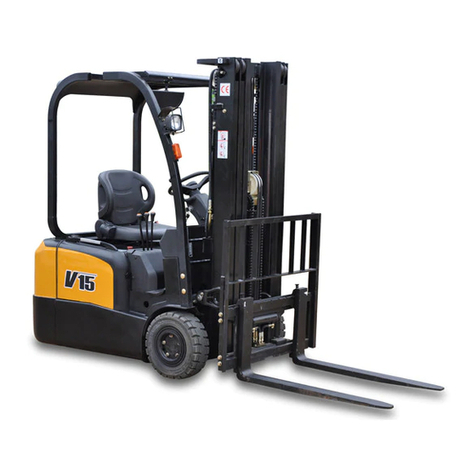
Big Joe
Big Joe V Series User manual

Big Joe
Big Joe T15 User manual
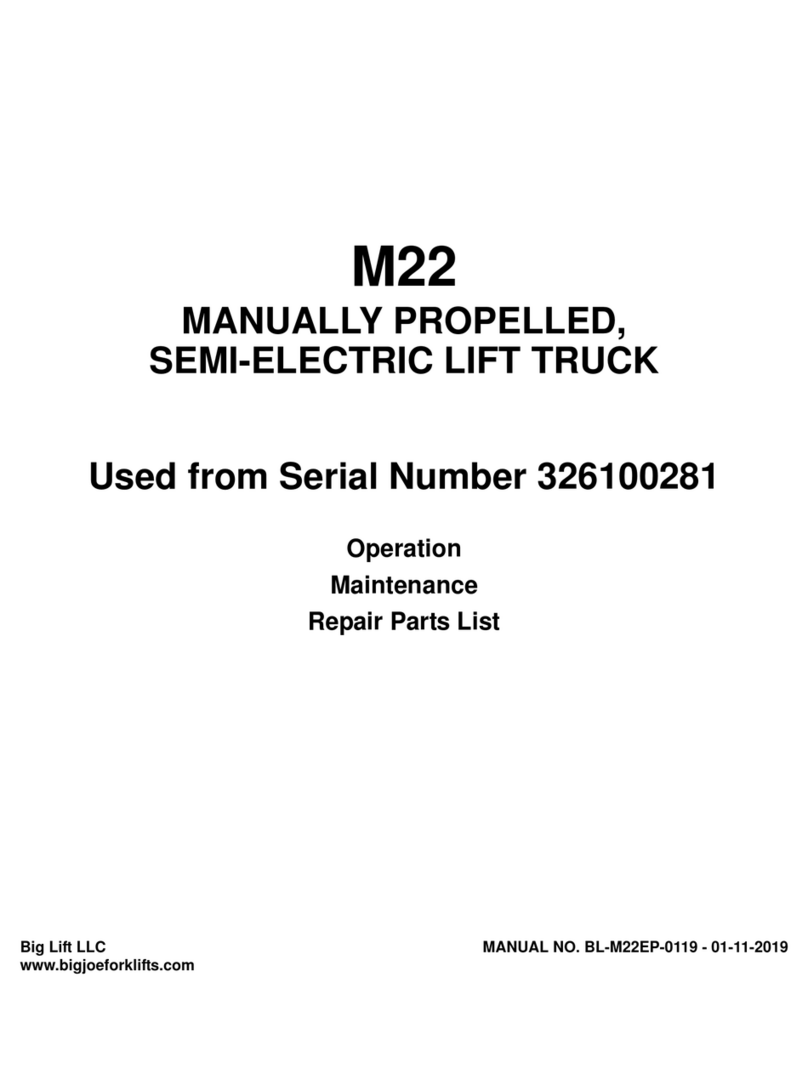
Big Joe
Big Joe M22 Use and care manual

Big Joe
Big Joe PDS 20 User manual

Big Joe
Big Joe E30 User manual
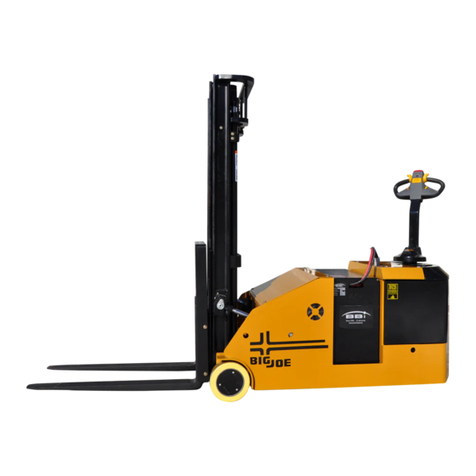
Big Joe
Big Joe CB33 User manual
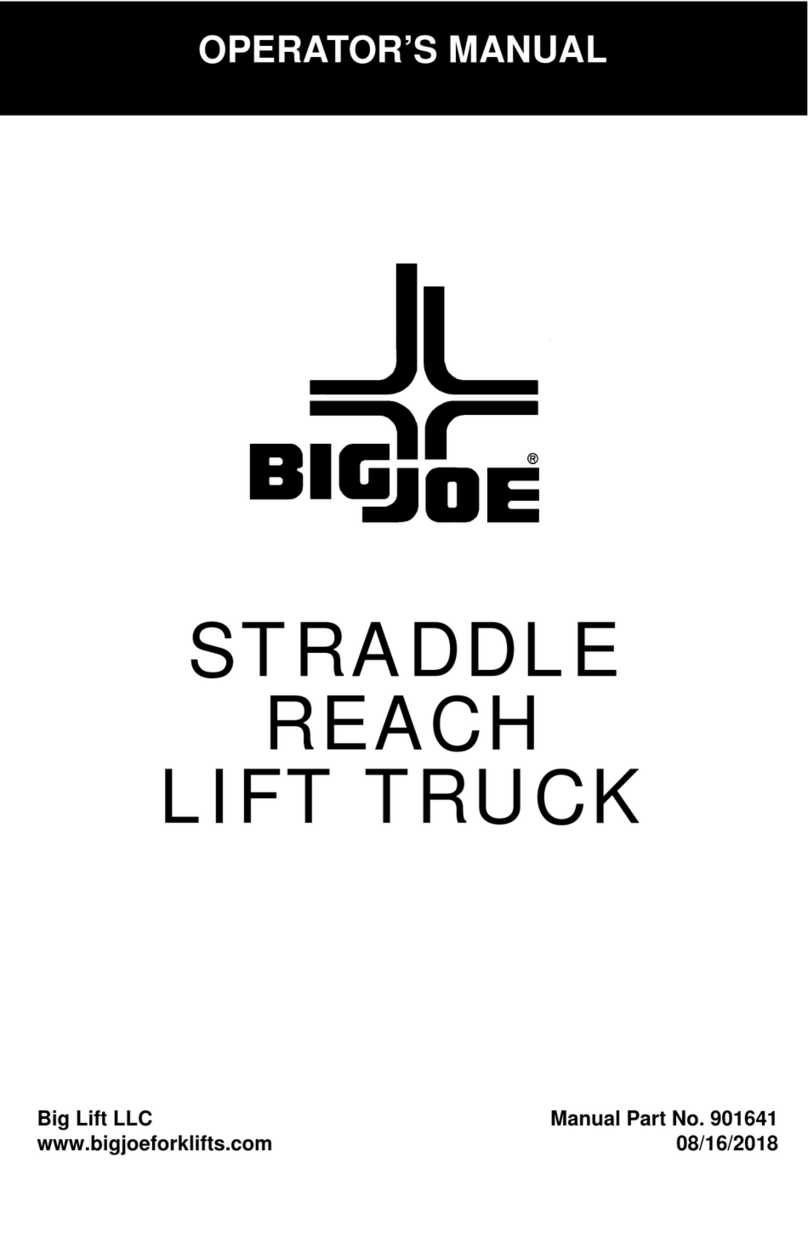
Big Joe
Big Joe PDSR User manual
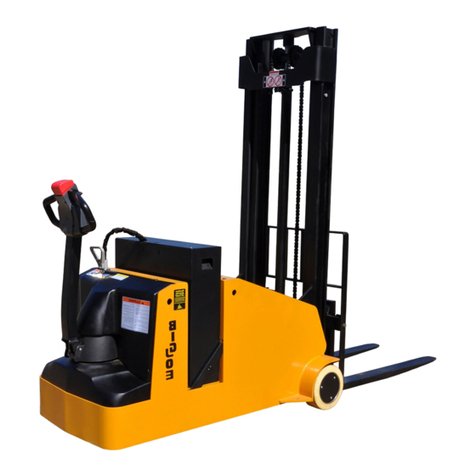
Big Joe
Big Joe CB22 User manual
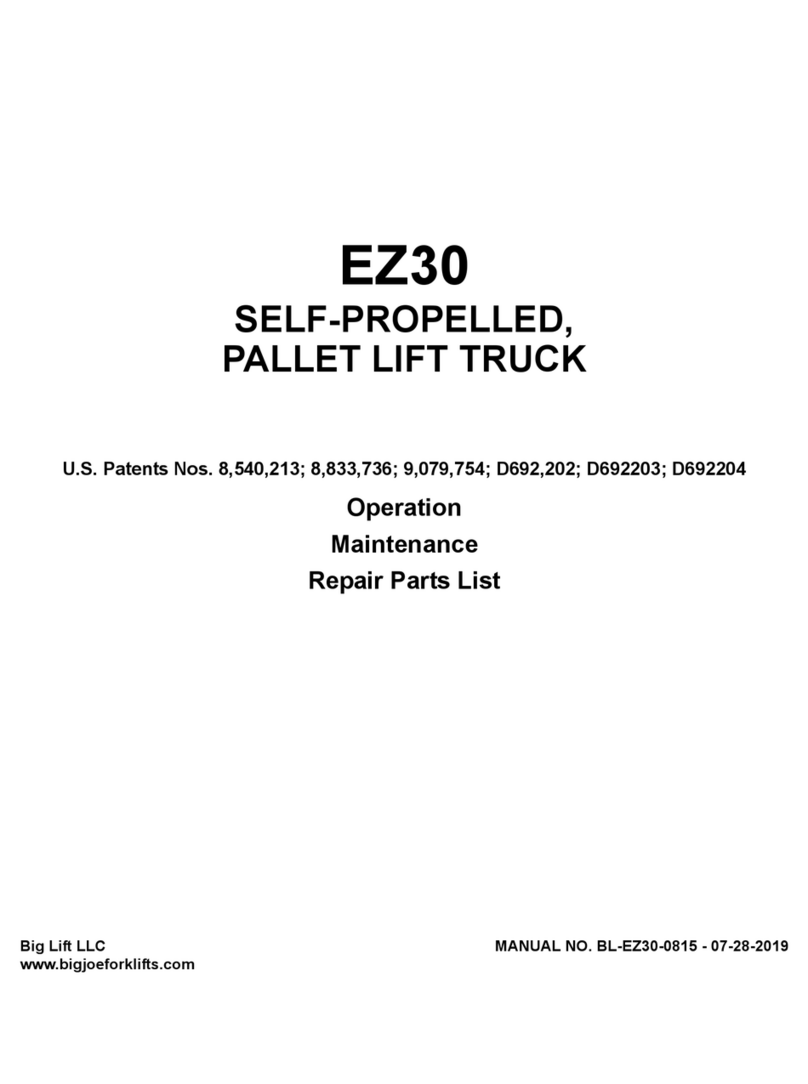
Big Joe
Big Joe EZ30 Use and care manual

Big Joe
Big Joe PPT 45 Series Use and care manual
